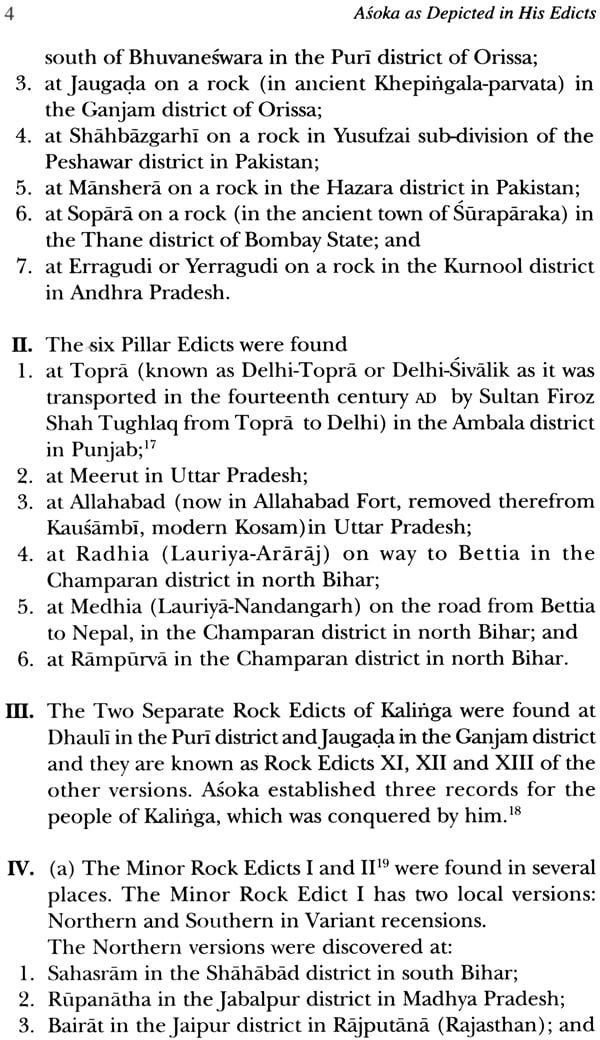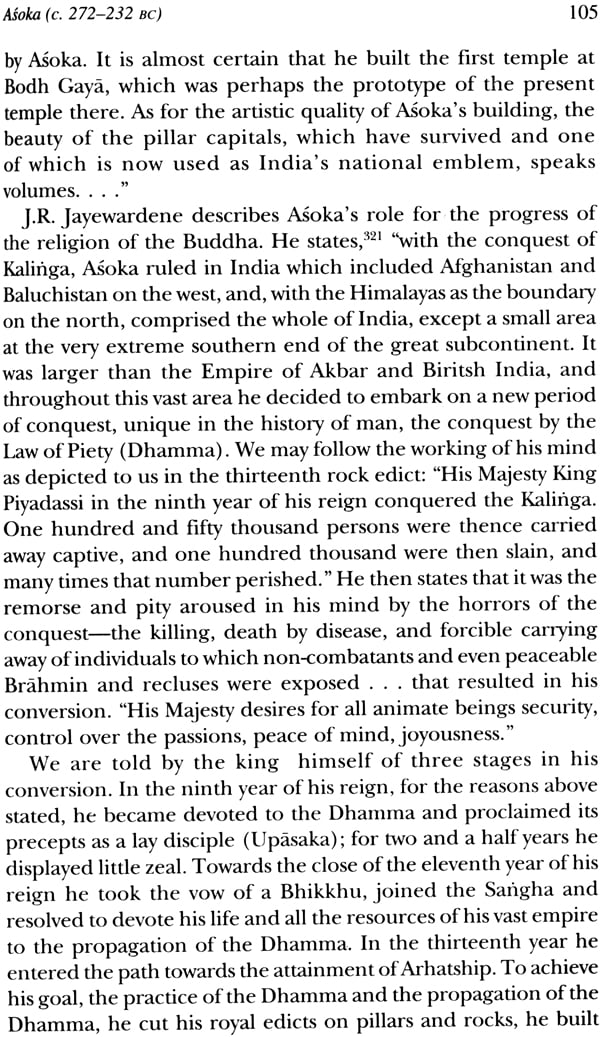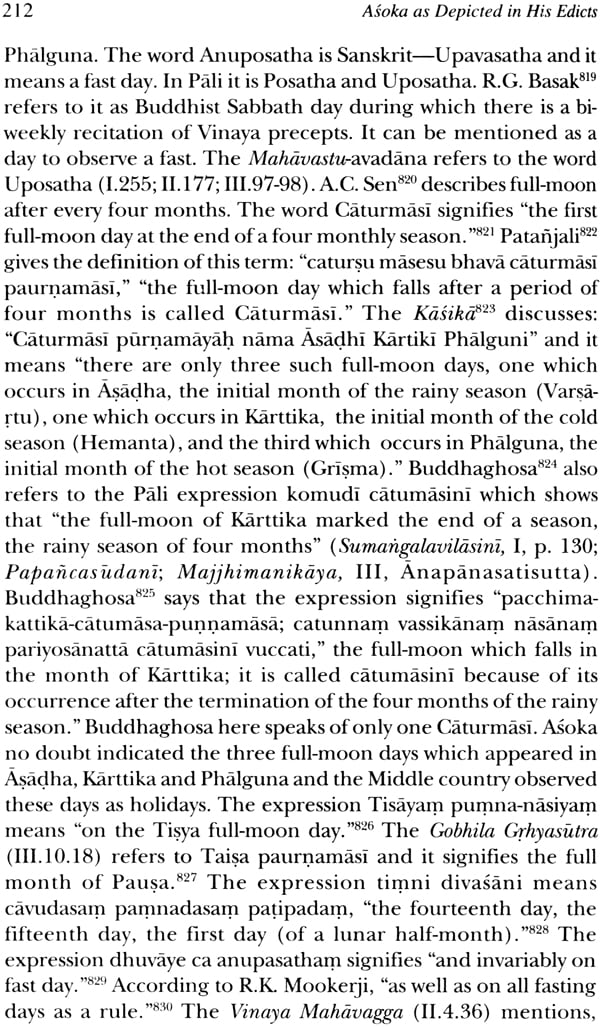
Asoka as Depicted in His Edicts
Book Specification
| Item Code: | IDK642 |
| Author: | Kanai Lal Hazra |
| Publisher: | Munshiram Manoharlal Publishers Pvt. Ltd. |
| Language: | English |
| Edition: | 2007 |
| ISBN: | 8121511674 |
| Pages: | 225 |
| Cover: | Hardcover |
| Other Details | 9.0" X 6.0" |
| Weight | 640 gm |
Book Description
The Purpose of this book entitled Asoka as Depicted in His Edicts, is to make the readers familiar with the history of the Maurya ruler Asoka. Scholars have written several works on Asoka's life, religion and philosophy, but no one seems to have taken any notice of this subject which analyses the important contributions of the edicts to Asoka's reign. The author has given a detailed account of these edicts and describes Asoka's reign and his significant part played by him in the religious world as narrated in them. Eminent scholars such as S.M. Barua, Jules Blech, G.S. Murti, A.N.K. Aiyangar, N.A. Nikom, V.A. Smith, Richard Mekeen, A.C. Woolner, G. Buhler, M.A. Mehendale, L.D. Barnett, A. Cunningham, R.K. Mookerji, G.P. Malalasekera, H.C. Raychaudhuri, B.G. Basak, H.G. Wells, J.M. Maephail, R.L. Turner, E.G. Rapson, F.W. Thomas, W.S. Schumacher, E. Hultzsch, Tuvis Golblum, T.W. Rhys Davids, B.G. Gokhale, Rev. H. Heras, H.C. Norman, E. Hardy, P.H.L. Eggermont, K.A. Nilakanta Sastri, R.C. Dutt, A.C. Sen, S. Bhattacharyya T. Chatterjee, C. Jinarajadasa, S.N. Ghosal, J.N. Samaddar, D.R. Sahni, C.C. Basu, D.C. Sirkar, R.D. Sarma, G.H. Ojha, D.K. Biswas, S.K. Mukhopadhyaya, Romila Thapar, J.R. Jayewardene and others have studied Asoka's reign and have given detailed accounts of his life and his reign. Despite the existence of several works relating to him, no critical historical life as depicted in his edicts has been available so far. This study tries its bet to fill the lacuna. It is based on a critical study of all edicts of Asoka and of all the available sours in the original and from them the author re-constructs Asoka's life and his services to the religion of the Buddha. This book presents a new perspective on the importance of the edicts in the literary world, re-assesses their value and then examines them in a proper way. In addition to those scurces references have also been made to other works. This book is an attempt to place all the relevant facts about Asoka. With this object in view the author has presented a lucid and an elaborate account of Asoka's life. H.G. Wells refers to Asoka as "one of the six greatest men of history the other being Buddha, Socrates, Aristotle, Roger Bacon, and Abraham Lincoln." In Asia he became a legendary figure and for his great patronage to Buddhism he became a well-known figure in Buddhist countries. No monarch of India has such a worldwide reputation and none has exerted such influence on the history of the world by his great efforts for righteousness and virtue.
The edicts or inscriptions of Asoka have their great values in the literary world. From them we learn about Asoka, his reign, his ideals and his strives to establish a rule of Dharma to his neighbours. They help to know about his greatness and his services to bring pace and happiness to man through moral regeneration. He desired and worked hard for the welfare of his people. In order to inform his aspirations, sincerity and earnestness to his people, he established those edicts in plain and simple language in his empire. "They form by themselves quite a handbook of moral and spiritual striving which in its entirety can be looked upon as a great book, not only for India but also for the whole of Humanity. Though not in their mystic content and outlook, but in their sincerity and spiritual striving, the inscriptions can be compared even with the earlier Upanisads and Tao-The-King of Las-taze." (A.C. Sen's Asoka's Edicts, P.V.) They give us authentic account of Asoka and they were engraved under his direction. Through the propagation of the religion he wanted to raise the morals of his subjects and for this reason they were created and were placed at the outset in his capital at Magadha. They are in the particular Prakrta dialects of the particular regions, the north-west, the mid-India, the West and the South.
The book is divided into five chapters. The first chapter deals with Asoka's reign, the classification of his edicts, the chronology of his edicts, his administration, his leanings towards Buddhism, his important role for the development of all sects, his prohibition of animal sacrifices, his propagation of the fundamental principles and practices of Dharma or moral life, his conversion to Buddhism, his contribution to the progress of Buddhism, his firm faith in the Buddha, the Dharma and the Sangha, his recommendation of certain canonical texts for the Buddhist monks and nuns, his zeal for the construction of the Buddhist viharas and stupas, the third Buddhist Council and the dispatch of nine Buddhist missionaries to nine different countries under his partronage for the introduction and growth of Buddhism there, and his conception of Dharma. The second chapter provides a clear and elegant description of the glossary of Asoka's edicts. The third chapter discusses his art and his contribution to its development. The fourth chapter gives an account of the causes of the downfall of the Maurya empire. The fifth chapter is a conclusion. This book has a bibliography and an index.
I am grateful to my brother Sri Subodh Kumar Mazra for his kind help for the publication of this book. I am thankful to Prof. Dr Mrinal Kanti Ganguly, Dr Daya Amarasekhara of the Department of Sociology of the University of Peradoniya, Sri Lanka and Dr Mrs Mani Kuntala Halder (De) for taking personal interest in my book.
My thanks are also due to the librarian, Central University Library, Calcutta University for helping me to use books in this library. I most also thank Mr Ashok Jain, Director, Munshiram Manoharlal Publishers for undertaking to publish this book.
The value of Asoka is greatly enhanced when we study and examine Asoka's lie, his reign and the great role played by him to reign the moral standard of his subjects. He himself perceived and visioned several issues which can be collected from a study of his edicts. Based on extensive research, this book presents a comprehensive survey of the life of this great ruler. The author looks at the subject both historically and analytically. It is an important contribution to the world of Buddhism and literature and to the study of Asoka's reign. It can be mentioned as the first major study of his life and it provides a unique body of evidence that throws new light on him. The author has produced it in a thoughtful manner and in a scholarly way and for this reason this book develops an integrated approach to understand him, his life and his services to Buddhism. To know and to study his reign it ought to be widely read and discussed. This clear and stimulating account will prove of absorbing interest to those engaged themselves in the study of his life. Based on edicts, this book challenges accepted idea relating to his reign and it makes an important contribution to ancient India history and culture. It provides a succinct survey of his edicts which are neatly analysed and literature on his reign.
This book brings together in an efficient and unified way virtually all that has been learned about his reign and the author has also gathered together from sources scattered throughout a wide range of the historical literature. This book is based on very sound research materials and it presents, describes and illustrates in a very lucid manner. It contains an interesting theme described in a thought-provoking manner and the author deserves appreciation because he presents before us an exhaustive work on Asoka and he has approached the subject with great care.
Dr. K.L. Hazra received his M.A., LL.B., and Diploma in French language from the University of Calcutta. He obtained his Ph.D. degree at the University of Peradoniya, Sri Lanka. He was a Commonwealth scholar. He is the author of a number of paper published in the noted journals and periodicals in English and Bengali. He is one of India's leading Indologists. He is a versatile scholar and is quite well-known for his contributions to the field of Buddhism. He is a well-known author of South and South-East Asian History and is one of the most influential thinkers of Buddhist history in India. He is the author of several books.
| Preface | ix | |
| Abbreviations | xiii | |
| Chapter 1. | Asoka (c. 273-232 BC) | 1 |
| Chapter 2. | Asoka's Edicts Glossary | 123 |
| Chapter 3. | An Account of Asoka's Art | 233 |
| Chapter 4. | Was Asoka Responsible for the Deciline of the Maurya Empire? | 265 |
| Chapter 5. | Conclusion | 281 |
| Bibliography | 291 | |
| Index | 301 | |





















